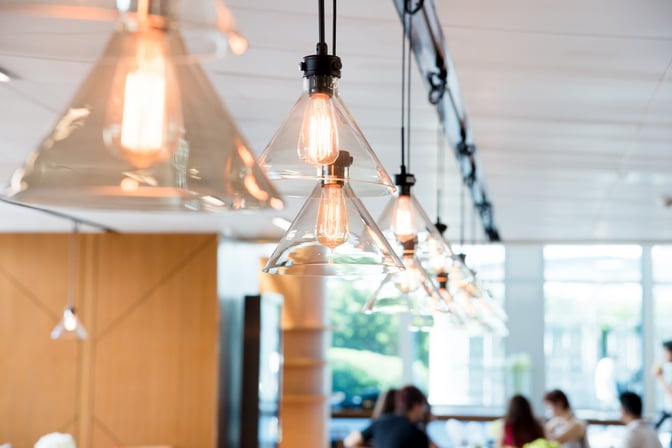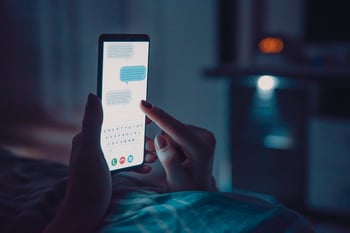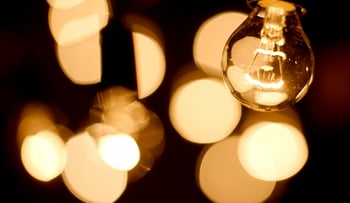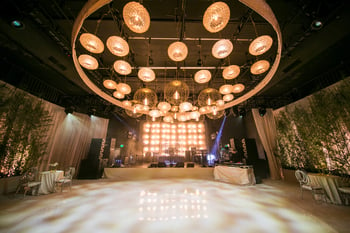by PORT on Nov 14, 2022 8:00:00 AM

Lighting has an immensely powerful effect on our circadian clocks (our internal body clocks) and the rhythm of our bodies. We’ve all heard about our circadian rhythms, but some may not know that light has a huge effect on our circadian clock and our health. Our bodies have a strong response to light, which tells our bodies when to wake up and when to fall asleep. As such, the more light we take in during the day, the more alert we are. Similarly, you can darken your bedroom when it’s time to rest to get a better night’s sleep.
Because light is so important to our sleep cycles, our lighting environment can also have a major impact on our overall health and well-being.
A healthy lighting environment can shape your life, day in and day out. Here are a few things to keep in mind about choosing lighting that fosters a positive, health-centered environment.
Indoor Lighting and Its Effect on Our Health
 Indoor lighting can have a major influence on our well-being. Light has a very deep-rooted connection to how we function, both physically and emotionally. For example, Green Business Certification, Inc. reports that a well-lit work environment has the power to boost productivity and improve people’s moods, send energy levels through the roof, and improve the well-being of our bodies and our minds.
Indoor lighting can have a major influence on our well-being. Light has a very deep-rooted connection to how we function, both physically and emotionally. For example, Green Business Certification, Inc. reports that a well-lit work environment has the power to boost productivity and improve people’s moods, send energy levels through the roof, and improve the well-being of our bodies and our minds.
A study shared by Green Business Certification, Inc. tracked the effects of lighting environments in 30 offices across 9 different cities. What this study found was that an astonishing 64 percent of offices had improper lighting that was too dim, and 60 percent of survey respondents working in these conditions reported issues like:
- Eye strain
- Dry eyes
- Eye irritation
- Fatigue
- Blurry vision
- Headaches
Harsh lighting can make people feel anxious or agitated. At the same time, lighting that is too dark or dim may lead people to feel unmotivated, especially during the winter months when days grow shorter.
Conversely, a great lighting environment can work wonders to improve our mental health. Very Well Mind shared that bright light can have an incredibly positive effect on symptoms of depression and anxiety. In fact, Rachelle Scott, MD and medical director of psychiatry at Eden Health stated that, “Lack of sunlight is a real concern with seasonal affective disorder (SAD) and a cornerstone of treatment is increasing light.”
How Our Bodies React to Light
Outside, the sun's rising and setting results in a gradual light shift. Inside, we often change our lighting environment just by turning a switch on or off. When we spend most of our waking hours in artificial light, that can affect the cycle of light and dark, disrupting our circadian rhythms. This actually can affect our health. Here’s why:
 Light impacts our bodies’ melatonin production, which is an important part of our sleep-wake cycle. As we are exposed to light (including the blue light from our computer and phone screens), our body shuts off the production of melatonin so we feel awake and alert. When the light begins to fade and it gets darker, our body releases melatonin to prepare us for sleep. But artificial light can interfere with these natural processes. This makes it harder to fall into a deep sleep, and it can alter our long-term health. This is because melatonin is a powerful, natural antioxidant. Low levels of melatonin are also linked to health issues like:
Light impacts our bodies’ melatonin production, which is an important part of our sleep-wake cycle. As we are exposed to light (including the blue light from our computer and phone screens), our body shuts off the production of melatonin so we feel awake and alert. When the light begins to fade and it gets darker, our body releases melatonin to prepare us for sleep. But artificial light can interfere with these natural processes. This makes it harder to fall into a deep sleep, and it can alter our long-term health. This is because melatonin is a powerful, natural antioxidant. Low levels of melatonin are also linked to health issues like:
- Cancer
- Diabetes
- Cardiovascular diseases
So how does light affect our sleep cycles? According to the Centers for Disease Control (CDC):
- Bright light (like blue light) two hours before bedtime will make you fall asleep later.
- Bright light in the morning will make you fall asleep earlier in the night. Bright light shortly after waking up will help you feel more alert.
What Does a Healthy Lighting Environment Look Like?
In architectural design, the workplace, and public spaces, lighting can set the tone for the mood, but it can also help foster a culture where health and positivity are prioritized.
Blue Light, Amber Light, and Circadian Lighting
 We hear a lot about the effects of late nights looking at the blue light from our screens and phones, but this quality of light is not always bad—in the right doses and at the right times. In fact, Nature recommends that people seek out bright light and blue light during daytime hours, as long as they are minimizing exposure to both once the sun goes down. Blue light can be beneficial; it’s why people with seasonal affective disorder use blue light boxes to boost their mood.
We hear a lot about the effects of late nights looking at the blue light from our screens and phones, but this quality of light is not always bad—in the right doses and at the right times. In fact, Nature recommends that people seek out bright light and blue light during daytime hours, as long as they are minimizing exposure to both once the sun goes down. Blue light can be beneficial; it’s why people with seasonal affective disorder use blue light boxes to boost their mood.
So what does this mean? A healthy lighting environment means incorporating some blue light. as well as lighting control systems to manage when these lights are blue and when they should shift to a softer shade when the sun sets. This can help improve mood and energy levels during the day.
Think of this like building a circadian lighting schedule. Circadian lighting mimics the natural light cycle day transitioning to night and vice versa. Circadian lighting shifts throughout the day, starting out warm amber in the morning and transitioning to more of a blue light during the brightest part of the day, then back to amber or red-spectrum light as you move closer to the end of the day.
Smart Lighting Control Systems
At PORT, one of our goals is always to help our clients create the environment that best serves them and meet their needs. That’s why we implement lighting systems that conserve energy through technologies like occupancy sensing, provide shade control, and offer lighting scheduling.
These smart lighting systems offer more control over lighting and can connect to wall panels, phones, and other Bluetooth devices, and provide options to create a lighting schedule that is healthy depending on the time of day to nurture a healthy circadian rhythm.
Setting the Right Light Levels
Finding the proper artificial lighting can be a challenge. After all, dim lighting can cause eye strain and headaches and can send energy levels plummeting. Harsh lighting can be just as bad, triggering eye strain and migraines making it difficult for our eyes to focus. At PORT, our experts will help you set the right lighting levels for every environment and time of day to avoid lighting that’s too dim or too severe, and even help you make the most of natural lighting and natural daylight light bulbs, which leads to happier workers, fewer illness-related absences, and increased productivity and satisfaction for building occupants.
Your Partner in Healthy Lighting
 At PORT, an important part of our mission is creating exceptional lighting experiences. That means more than just beautiful lighting, but lighting that nurtures your well-being, too.
At PORT, an important part of our mission is creating exceptional lighting experiences. That means more than just beautiful lighting, but lighting that nurtures your well-being, too.
Don’t get us wrong—we love beautiful lighting. As part of our design, we’ll help you choose stunning lighting options that are also great for your health.
From the first consultation to the finished flip of a light switch, we’ll take care of everything from preliminary lighting to final installation. We’re your experts in architectural, commercial, and theatrical lighting, with years of experience cultivating positive, productive, smart lighting designs.
It’s time to let our team use the power of lighting to make your space happier and healthier and achieve all your lighting goals. To learn more, connect with our team today.
 We hear a lot about the effects of late nights looking at the blue light from our screens and phones, but this quality of light is not always bad—in the right doses and at the right times. In fact, Nature recommends that people seek out bright light and blue light during daytime hours, as long as they are minimizing exposure to both once the sun goes down. Blue light can be beneficial; it’s why people with seasonal affective disorder use blue light boxes to boost their mood.
We hear a lot about the effects of late nights looking at the blue light from our screens and phones, but this quality of light is not always bad—in the right doses and at the right times. In fact, Nature recommends that people seek out bright light and blue light during daytime hours, as long as they are minimizing exposure to both once the sun goes down. Blue light can be beneficial; it’s why people with seasonal affective disorder use blue light boxes to boost their mood. At PORT, an important part of our mission is creating exceptional lighting experiences. That means more than just beautiful lighting, but lighting that nurtures your well-being, too.
At PORT, an important part of our mission is creating exceptional lighting experiences. That means more than just beautiful lighting, but lighting that nurtures your well-being, too.



 Light
Light 
No Comments Yet
Let us know what you think